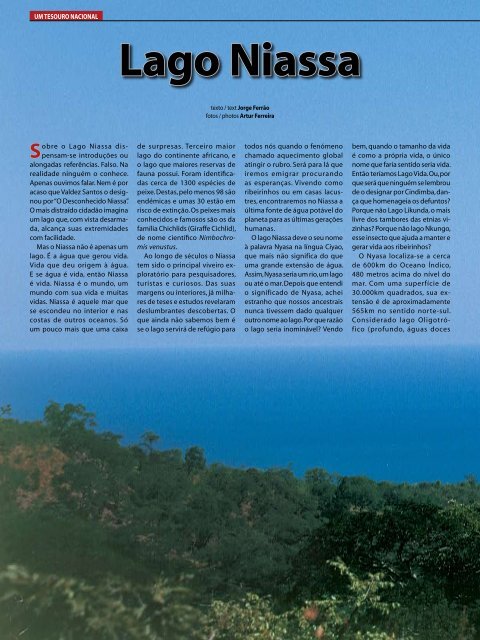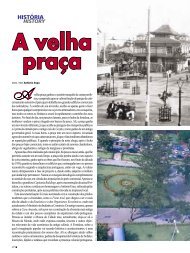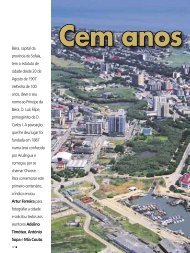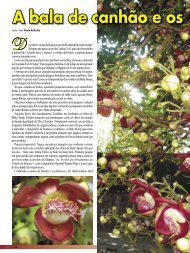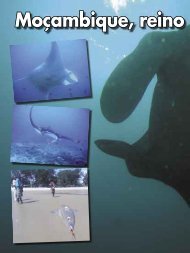You also want an ePaper? Increase the reach of your titles
YUMPU automatically turns print PDFs into web optimized ePapers that Google loves.
UM TESOURO NACIONAL<br />
Sobre o <strong>Lago</strong> <strong>Niassa</strong> dispensam-se<br />
introduções ou<br />
alongadas referências. Falso. Na<br />
realidade ninguém o conhece.<br />
Apenas ouvimos falar. Nem é por<br />
acaso que Valdez Santos o designou<br />
por “O Desconhecido <strong>Niassa</strong>”.<br />
O mais distraído cidadão imagina<br />
um lago que, com vista desarmada,<br />
alcança suas extremidades<br />
com facilidade.<br />
Mas o <strong>Niassa</strong> não é apenas um<br />
lago. É a água que gerou vida.<br />
Vida que deu origem à água.<br />
E se água é vida, então <strong>Niassa</strong><br />
é vida. <strong>Niassa</strong> é o mundo, um<br />
mundo com sua vida e muitas<br />
vidas. <strong>Niassa</strong> é aquele mar que<br />
se escondeu no interior e nas<br />
costas de outros oceanos. Só<br />
um pouco mais que uma caixa<br />
34<br />
<strong>Lago</strong> <strong>Niassa</strong><br />
de surpresas. Terceiro maior<br />
lago do continente africano, e<br />
o lago que maiores reservas de<br />
fauna possui. Foram identificadas<br />
cerca de 1300 espécies de<br />
peixe. Destas, pelo menos 98 são<br />
endémicas e umas 30 estão em<br />
risco de extinção. Os peixes mais<br />
conhecidos e famosos são os da<br />
família Chichlids (Giraffe Cichlid),<br />
de nome científico Nimbochromis<br />
venustus.<br />
Ao longo de séculos o <strong>Niassa</strong><br />
tem sido o principal viveiro exploratório<br />
para pesquisadores,<br />
turistas e curiosos. Das suas<br />
margens ou interiores, já milhares<br />
de teses e estudos revelaram<br />
deslumbrantes descobertas. O<br />
que ainda não sabemos bem é<br />
se o lago servirá de refúgio para<br />
texto / text Jorge Ferrão<br />
fotos / photos Artur Ferreira<br />
todos nós quando o fenómeno<br />
chamado aquecimento global<br />
atingir o rubro. Será para lá que<br />
iremos emigrar procurando<br />
as esperanças. Vivendo como<br />
ribeirinhos ou em casas lacustres,<br />
encontraremos no <strong>Niassa</strong> a<br />
última fonte de água potável do<br />
planeta para as últimas gerações<br />
humanas.<br />
O lago <strong>Niassa</strong> deve o seu nome<br />
à palavra Nyasa na língua Ciyao,<br />
que mais não significa do que<br />
uma grande extensão de água.<br />
Assim, Nyasa seria um rio, um lago<br />
ou até o mar. Depois que entendi<br />
o significado de Nyasa, achei<br />
estranho que nossos ancestrais<br />
nunca tivessem dado qualquer<br />
outro nome ao lago. Por que razão<br />
o lago seria inominável? Vendo<br />
bem, quando o tamanho da vida<br />
é como a própria vida, o único<br />
nome que faria sentido seria vida.<br />
Então teríamos <strong>Lago</strong> Vida. Ou, por<br />
que será que ninguém se lembrou<br />
de o designar por Cindimba, dança<br />
que homenageia os defuntos?<br />
Porque não <strong>Lago</strong> Likunda, o mais<br />
livre dos tambores das etnias vizinhas?<br />
Porque não lago Nkungo,<br />
esse insecto que ajuda a manter e<br />
gerar vida aos ribeirinhos?<br />
O Nyasa localiza-se a cerca<br />
de 600km do Oceano Índico,<br />
480 metros acima do nível do<br />
mar. Com uma superfície de<br />
30.000km quadrados, sua extensão<br />
é de aproximadamente<br />
565km no sentido norte-sul.<br />
Considerado lago Oligotrófico<br />
(profundo, águas doces
Índico 35
e sem plâncton), ele situa-se na<br />
falha geológica conhecida por<br />
grande Vale do Rift, atingindo,<br />
em determinados locais, 1.500<br />
metros de profundidade. Junto<br />
à costa, o lago chega a ter profundidades<br />
até aos 200 metros,<br />
com a temperatura da água estável<br />
nos 22 graus centígrados.<br />
Um verdadeiro paraíso para os<br />
mergulhadores.<br />
VISITAR O LAGO E NIASSA<br />
É OBRIGATÓRIO<br />
Visitar o lago é algo que todos<br />
os moçambicanos deveriam fazer,<br />
não importa a idade e muito<br />
menos a época do ano. No Nyasa<br />
qualquer altura do ano é boa<br />
para uma volta. Por ar, a opção<br />
será fazer escala em Lichinga e<br />
depois seguir de carro para Metangula<br />
ou Meponda, sendo a<br />
viagem até Metangula uma das<br />
mais agradáveis no interior da<br />
província. A estrada é asfaltada<br />
e a paisagem fascinante, sendo<br />
digna de registo a cadeia montanhosa<br />
Maniamba-Amaramba,<br />
interrompida pelas manchas<br />
de Karoo. A vegetação é, por<br />
si só, um outro e memorável<br />
espectáculo.<br />
Em Meponda, Ngo, Chuanga ou<br />
36<br />
Kóbwè, do lado de Moçambique,<br />
é fácil embarcar no cruzeiro “Ilala”.<br />
A acostagem é feita uma vez por<br />
semana e, devido às proporções<br />
do navio, o transbordo é feito em<br />
pequenas embarcações. Depois<br />
da paragem em Moçambique, o<br />
cruzeiro segue para outros destinos<br />
no Malawi. É sempre uma<br />
oportunidade para conhecer e<br />
visitar a Ilha de Likoma. Vale pela<br />
infra-estrutura que foi criada e<br />
pela beleza natural, da qual se<br />
reveste.<br />
O roteiro do “Ilala” termina na<br />
Monkey Bay, já do lado do Malawi,<br />
sem que antes passe por Sanga<br />
Bay. A viagem pode durar entre<br />
cinco a sete dias, com ondulação<br />
em dias de ventos fortes quando<br />
aquele mar de água se transforma<br />
num monstro, um Adamastor dos<br />
novos tempos.<br />
Existem várias referências escritas<br />
sobre o Nyasa. Algumas datam<br />
de 1619 e devem-se a Gaspar<br />
Bocarro que, na sua viagem de<br />
Tete para Quíloa, esteve nas suas<br />
margens. Todavia, os escritos dos<br />
exploradores ingleses, ou financiados<br />
pela Inglaterra, ganharam<br />
maior expressão ao longo dos<br />
séculos. Cecil Rodhes, Henry<br />
Stanley, apenas para citar alguns,<br />
são referências incontornáveis no<br />
estudo do lago.<br />
Segundo reza a história, Livingstone,<br />
célebre escocês, descobriu<br />
o lago em 1859. Mas outras<br />
referências mais próximas revelam<br />
também que o português<br />
Baltazar Rebelo de Aragão, ao<br />
serviço do governador de Angola,<br />
D. Manuel Pereira Forjaz, avistara<br />
o lago já no longínquo ano de<br />
1560, quando tentava a travessia<br />
do continente africano de oeste<br />
para leste.<br />
O jornalista britânico Basil<br />
Davidson, autor de memoráveis<br />
reportagens sobre África, visitou<br />
<strong>Niassa</strong> em1968. Não falou apenas<br />
do <strong>Lago</strong>, mas também de Matchedje.<br />
Usando a caneta como<br />
arma, foi um dos convidados ao<br />
II Congresso de Frelimo. Passaram-se<br />
40 anos. Matchedje revive.<br />
Placas, pontes, fotos, as mesmas<br />
copas de árvores. Anos de história<br />
e glória que perdurarão para<br />
sempre na memória dos viventes<br />
e descendentes.
A NATIONAL EX-LIBRIS<br />
Lake <strong>Niassa</strong> needs no introductions<br />
or lengthy references.<br />
Wrong. The truth is that nobody<br />
knows it. We only hear people<br />
speak about it. It was not by<br />
chance that Valdez Santos called<br />
it the “Unknown <strong>Niassa</strong>”. The less<br />
attentive citizen imagines a lake<br />
which, to the naked eye, reaches<br />
its extremities with ease.<br />
However, <strong>Niassa</strong> is not just a<br />
lake. It is the water that created<br />
life, the life that gave birth to water.<br />
And if water is life, then <strong>Niassa</strong><br />
is life. <strong>Niassa</strong> is the world, a world<br />
with its own life and many other<br />
lives. <strong>Niassa</strong> is the sea that concealed<br />
itself inland, behind the<br />
back of other oceans. It is a little<br />
more than a box full of surprises.<br />
It is the third largest lake on the<br />
African continent and the lake<br />
with the greatest wildlife reserves.<br />
Around 1300 species of fish have<br />
been identified. Among these, at<br />
least 98 are endemic and about 30<br />
are at risk of extinction. The most<br />
known and famous fish belong<br />
38<br />
Lake <strong>Niassa</strong><br />
to the Cichlidae family (Giraffe<br />
Cichlid), whose scientific name is<br />
Nimbochromis venustus.<br />
For centuries, <strong>Niassa</strong> has been<br />
the main exploration source<br />
for researchers, tourists and<br />
amateurs. From its shores or the<br />
inland, thousands of studies have<br />
already revealed dazzling discoveries.<br />
What we still do not know<br />
is whether the lake will serve as a<br />
refuge for all of us when the level<br />
of the phenomenon called global<br />
warming reaches code red. Will<br />
we emigrate there in search of<br />
hope? Living like riparians or in<br />
lacustrine dwellings, we will find<br />
in it the last source of drinkable<br />
water on the planet for the last<br />
human generations.<br />
Lake <strong>Niassa</strong> owes its name<br />
to the word Nyasa in the Ciyao<br />
language, meaning no more than<br />
a great stretch of water. Hence,<br />
Nyasa could be a river, a lake or<br />
even a sea. Having learned of the<br />
meaning of Nyasa, I thought it<br />
strange that our ancestors never<br />
gave the lake a different name.<br />
Why would the lake be unnameable?<br />
On closer inspection, when<br />
the largeness of life is as large as life<br />
itself, the only name that would<br />
make sense would be life. So we<br />
would have Lake Life. Likewise,<br />
why is it that nobody remembered<br />
to name it Cindimba, after the<br />
dance that pays homage to the<br />
deceased? Why not Lake Likunda,<br />
after the freest of the drums of<br />
the neighbouring ethnic groups?<br />
Why not Lake Nkungo, after the<br />
insect that helps to maintain and<br />
give life to the riparians?<br />
Nyasa lies at around 600km<br />
from the Indian Ocean, at 480 metre<br />
above sea level. With an area<br />
of 30,000 square km, it extends<br />
approximately 565km from north<br />
to south. Considered to be an oligotrophic<br />
lake (deep, freshwater<br />
and free of plankton), it is situated<br />
on a geological fault known as<br />
the Great Rift Valley, reaching at<br />
certain points a depth of 1,500<br />
metres. Along the coast, the lake<br />
has depths of up to 200 metres<br />
with a stable water temperature<br />
of 22 degrees Celsius. It is a true<br />
paradise for divers.<br />
THE LAKE AND NIASSA,<br />
A MUST TOUR<br />
Paying a visit to the lake is<br />
something that all Mozambicans<br />
should do, regardless of their age<br />
or the time of the year. If you want<br />
to see the Nyasa, any time of the<br />
year is a good time to come. If you<br />
are flying in, the best option is to<br />
make a stopover in Lichinga and<br />
continue by car to Metangula or<br />
Meponda. The journey to Metangula<br />
is one of the most enjoyable<br />
in the province. The road is paved<br />
and the landscape is fascinating.<br />
Worthy of note is the Maniamba-Amaramba<br />
mountain chain,<br />
cut off by specks of the Karoo.<br />
Vegetation alone is another memorable<br />
spectacle.<br />
In Meponda, Ngo, Chuanga or<br />
Kóbwè, on the Mozambican side,<br />
it is easy to board the Ilala cruise
Índico 39
Nkungo no lago sem nome Nkungo on the Nameless Lake<br />
À terceira foi de vez. Não há duas<br />
sem três. Fui ao lago sem nome<br />
procurando Nkungo, (nome<br />
científico Chironomidae). Opção<br />
no mínimo invulgar. Poderia ter<br />
ido para desvendar os segredos<br />
de Meponda, desfrutar das<br />
praias cristalinas de Kóbwè, Ngo,<br />
Chuanga ou relaxar no cruzeiro<br />
transafricano “Ilala”. Poderia,<br />
enfim, deixar que o feitiço das<br />
águas me devolvesse para os<br />
céus e contemplasse o interminável<br />
desfile de raridades.<br />
Mas foi o Nkungo que remexeu<br />
com meus interiores, minhas<br />
curiosidades. Esse insecto, rico<br />
em proteína, ferro e cálcio, que<br />
ao longo de décadas serve de<br />
delicatessen às restritas mesas<br />
dos ribeirinhos. Nkungo, pela<br />
sua raridade, preenche algumas<br />
horas de canais de TV como o<br />
Discover e o National Geographic.<br />
Nkungo é um insecto de tamanho<br />
ligeiramente superior ao<br />
mosquito, da família dos Diptros.<br />
A sua designação mais comum<br />
em inglês é Lake Fly. Nkungo é<br />
mais escuro e bem mais útil que<br />
o mosquito. Todos os ribeirinhos<br />
o conhecem e desfrutaram<br />
de seus sabores. Aliás, conta a<br />
tradição que o Nkungo fecunda<br />
e se reproduz no interior de um<br />
peixe gigante do lago. Escuro e<br />
desconhecido, esse peixe apenas<br />
vem à superfície de vez em<br />
quando, para respirar e libertar<br />
suas crias, momento em que ele<br />
expele o Nkungo. O peixe é o<br />
dono do lago e de todas as vidas<br />
do lago.<br />
Nkungo é uma designação de<br />
origem Nyanja. Nem por menos,<br />
foi nas proximidades do lago<br />
que a etnia desbravou seu<br />
40<br />
espaço e sua civilização. Na realidade,<br />
os ensaios científicos dão<br />
conta que o Nkungo se origina<br />
de uma larva que é depositada<br />
na superfície do lago. Na<br />
época da reprodução geram-se<br />
milhões de novos insectos que,<br />
ainda em estado vulnerável, são<br />
arrastados pelos ventos, sendo a<br />
costa o destino de uma grande<br />
parte deles. Neste percurso,<br />
entre o local de nascença e a<br />
costa, forma-se uma nuvem<br />
escura que sobrevoa, baixo, por<br />
cima do lago.<br />
Do lado da costa, quer em Moçambique<br />
como no Malawi, as<br />
mulheres, sobretudo elas, pegam<br />
em peneiras (cestos de palha circulares<br />
e abertos), molham-nos<br />
e apenas deixam que o Nkungo<br />
se encoste. É uma caçada fácil<br />
e ambientalmente correcta. É o<br />
final prematuro de uma vida que<br />
dura algumas horas e um único<br />
vento. Uma vez retirado das<br />
peneiras, o Nkungo é amalgamado,<br />
seco e depois confeccionado<br />
com um dos ingredientes de um<br />
saboroso prato local. As formas<br />
de preparo variam, podendo ser<br />
consumido ensopado ou até<br />
como uma espécie de mukate/<br />
mikate (pão tradicional). Tem um<br />
sabor diferente do comum, mas<br />
nem por isso menos saboroso. É<br />
pelo menos mais rico e nutritivo.<br />
O certo é que o Nkungo pode<br />
ser conservado por muito<br />
tempo.<br />
Chironomidae<br />
Third time’s a charm. I went to<br />
the nameless lake in search of<br />
the Nkungo, an unusual choice<br />
to say the least. I could have<br />
gone to unravel the secrets of<br />
Meponda, enjoy the crystalclear<br />
beaches of Kóbwè, Ngo,<br />
and Chuanga or relax on the<br />
transafrican Ilala cruise ship.<br />
I could have, at last, let the<br />
enchantment of the waters<br />
send me back to the skies and<br />
mused on the endless display<br />
of rarities. But it was the<br />
Nkungo that stirred my inner<br />
curiosity. This insect, rich in protein,<br />
iron and calcium has for<br />
decades been used as a delicatessen<br />
on the selected tables of<br />
the riparians. Due to its rarity,<br />
the Nkungo receives hours<br />
of TV coverage on channels<br />
such as Discovery and National<br />
Geographic.<br />
Nkungo is an insect slightly<br />
larger than a mosquito, belonging<br />
to the Diptera order. Its<br />
most common English name is<br />
Lake Fly. Nkungo is darker and<br />
a lot more useful than a mosquito.<br />
All riparians know it and<br />
are delighted with its flavour.<br />
As a matter of fact, tradition<br />
has it that the Nkungo breeds<br />
inside a giant fish in the lake.<br />
Dark and unknown, this fish<br />
only comes up to the surface<br />
once in a while to breathe and<br />
release its offspring, the same<br />
moment at which it ejects the<br />
Nkungo. This fish is king of the<br />
lake and all the lake’s wildlife.<br />
Nkungo is a word originating<br />
from the Nyanja language. And<br />
it was precisely in the vicinity<br />
of the lake that this ethnic<br />
group found its place and<br />
built its civilization. Actually,<br />
scientific studies conclude<br />
that the Nkungo originates in<br />
a larva which is deposited on<br />
the lake’s surface. During the<br />
reproductive season, millions<br />
of new insects are born, driven<br />
by the winds while still in their<br />
vulnerable stage, with the<br />
shore serving as destination for<br />
a great many of them. Along<br />
this journey from their place<br />
of birth to the shore, they form<br />
a black cloud that hovers low<br />
above the lake.<br />
On the shore, both in Mozambique<br />
and Malawi, women<br />
(mainly women) take their<br />
peneiras (round and open straw<br />
baskets), drench them and<br />
just let the Nkungo rest. It is<br />
an easy and environmentally<br />
correct way of hunting, the<br />
premature end of a life that<br />
lasts for a couple of hours and<br />
one sole gust of wind. Once it<br />
is removed from the peneiras,<br />
the Nkungo is pressed, dried<br />
and later prepared with one of<br />
the ingredients of a tasty local<br />
dish. The preparation methods<br />
vary. It can be cooked as a stew<br />
or even as a type of mukate/<br />
mikate (traditional bread). It is<br />
unusual but tasty. It is at least<br />
richer and nutritious, and it<br />
certainly can be preserved for<br />
a long time.
ship. Boarding takes place once a<br />
week, and due to the ship’s size,<br />
transhipment is done in small<br />
boats. After the stop in Mozambique,<br />
the cruise ship continues<br />
to other destinations in Malawi.<br />
It is always a great opportunity to<br />
get to know and visit the island of<br />
Likoma, for the infrastructure that<br />
was built there and for the spread<br />
out natural beauty.<br />
Ilala’s itinerary ends at Monkey<br />
Bay, already on the Malawi side,<br />
but not before also passing<br />
Sanga Bay. The journey can last<br />
between five and seven days and<br />
there is undulation on days of<br />
strong winds, when the sea turns<br />
into a monster, a present-day<br />
Adamastor.<br />
There are several written references<br />
about Nyasa. Some date<br />
back to 1619 and are the work of<br />
Gaspar Bocarro, who visited its<br />
shores on his journey from Tete<br />
to Kilwa. The writings of English<br />
explorers, or those financed by<br />
England, however, found more expression<br />
over the centuries. Cecil<br />
Rhodes and Henry Stanley, to name<br />
a few, are inevitable references<br />
when studying the lake.<br />
According to history, Livingstone,<br />
the renowned Scotsman,<br />
discovered the lake in 1859. Other<br />
more recent references, however,<br />
also reveal that the Portuguese<br />
Baltazar Rebelo de Aragão, at<br />
the service of the governor of<br />
Angola, D. Manuel Pereira Forjaz,<br />
had caught site of the lake as far<br />
back as 1560 when he tried to<br />
cross the African continent from<br />
west to east.<br />
British journalist Basil Davidson,<br />
author of memorable reports on<br />
Africa, visited <strong>Niassa</strong> in 1968. He<br />
did not speak only about the lake,<br />
but also about Matchedje. Using<br />
his pen as a weapon, he was one<br />
of the invitees at the Second Frelimo<br />
Congress. Forty years have<br />
passed. Matchedje relives through<br />
plaques, bridges, photographs,<br />
the same treetops. Years of history<br />
and glory that will remain forever<br />
in the memory of the living and<br />
their descendents.<br />
Índico 41


